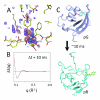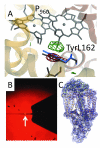Time-resolved structural studies at synchrotrons and X-ray free electron lasers: opportunities and challenges
- PMID: 23021004
- PMCID: PMC3520507
- DOI: 10.1016/j.sbi.2012.08.006
Time-resolved structural studies at synchrotrons and X-ray free electron lasers: opportunities and challenges
Abstract
X-ray free electron lasers (XFELs) are potentially revolutionary X-ray sources because of their very short pulse duration, extreme peak brilliance and high spatial coherence, features that distinguish them from today's synchrotron sources. We review recent time-resolved Laue diffraction and time-resolved wide angle X-ray scattering (WAXS) studies at synchrotron sources, and initial static studies at XFELs. XFELs have the potential to transform the field of time-resolved structural biology, yet many challenges arise in devising and adapting hardware, experimental design and data analysis strategies to exploit their unusual properties. Despite these challenges, we are confident that XFEL sources are poised to shed new light on ultrafast protein reaction dynamics.
Copyright © 2012 Elsevier Ltd. All rights reserved.
Figures



References
-
- Ihee H, Wulff M, Kim J, S. I. A: Ultrafast X-ray scattering: structural dynamics from diatomic to protein molecules. Int Rev Phys Chem. 2010;29:453–520.
-
- Cammarata M, Eybert L, Ewald F, Reichenbach W, Wulff M, Anfinrud P, Schotte F, Plech A, Kong Q, Lorenc M, Lindenau B, et al. Chopper system for time resolved experiments with synchrotron radiation. Rev Sci Instrum. 2009;80:015101. - PubMed
-
- Schotte F, Lim M, Jackson TA, Smirnov AV, Soman J, Olson JS, Phillips GN, Jr., Wulff M, Anfinrud PA. Watching a protein as it functions with 150-ps time-resolved x-ray crystallography. Science. 2003;300:1944–1947. - PubMed
-
-
Cho HS, Dashdorj N, Schotte F, Graber T, Henning R, Anfinrud P. Protein structural dynamics in solution unveiled via 100-ps time-resolved x-ray scattering. Proc Natl Acad Sci U S A. 2010;107:7281–7286. * This paper provides tantalizing clues that significant conformational changes are occurring in Mb:CO on a time scale faster than 100 ps, which is the current state-of-the-art in time resolved WAXS at synchrotron sources.
-
-
-
Emma P, Akre R, Arthur J, Bionta R, Bostedt C, Bozek J, Brachmann A, Bucksbaum PH, Coffee R, Decker FJ, Ding Y, et al. First lasing and operation of an angstrom-wavelength free-electron laser. Nat Photon. 2010;4:641–647. * This is a landmark paper marking the first lasing at hard X-ray wavelengths at the LCLS.
-
Publication types
MeSH terms
Grants and funding
LinkOut - more resources
Full Text Sources

